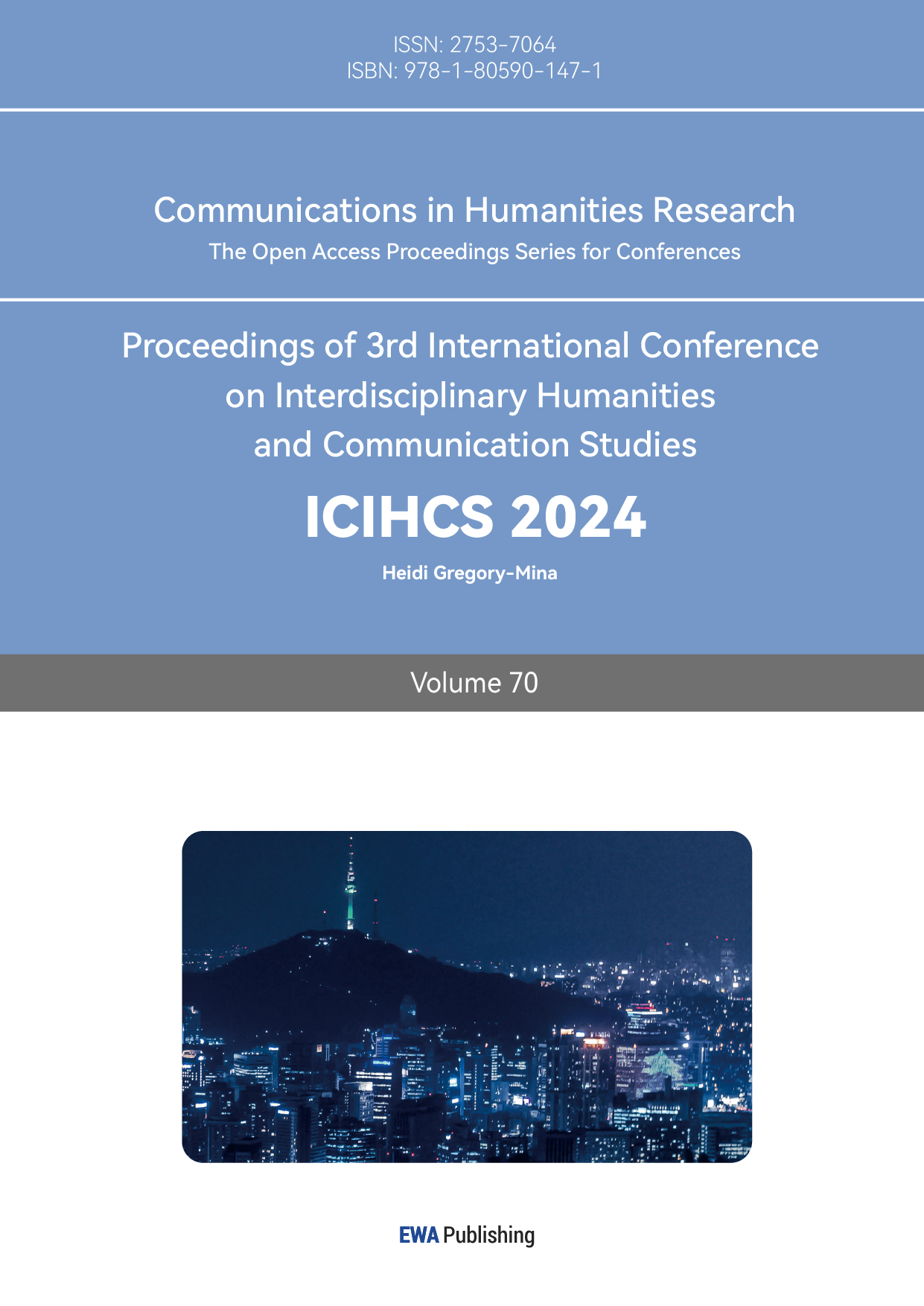1. Introduction
Luxury brands are considered to be captivating to a majority of consumers of different demographics mainly because of their aspect of exclusivity, impeccable craftsmanship in their design, and the allure that they command. In the past, luxury brands have relied on traditional marketing strategies such as lavish fashion shows, glossy print advertisements, and strategic celebrity endorsements to appeal to their target market and promote their individual brands [1]. However, in the recent past, there has been an increase in the number of consumers, or target market for luxury brands falling in the Millennials and Generation Z age demographic. For these groups of target consumers, the utilization of traditional marketing and promotion approaches may not be as effective. The emergence of different social media platforms such as Facebook, Instagram and TikTok has revolutionized the way, and approach that brands use to interact with their target audience. In particular, the younger generation spends most of their time on digital platforms for consumption of information, entertainment, and ‘updating’ their lives [2]. With advanced technology, exclusivity and uniqueness can be communicated to consumers on social media sites [3]. Brands develop their own unique strategy in order to attract younger consumers. Luxury brands are embracing the use of social media as an important and essential marketing tool for their products. They are also coming up with strategies to enhance or improve brand awareness, boost engagement levels and drive sales. The direct interaction between the consumers and the luxury brand products, which is facilitated by social media platforms, has enabled brands to be in a position where they can engage in real-time with the consumers, garner their feedback, provide customer services, and foster brand loyalty [4]. Visual platforms such as Instagram are becoming instrumental in terms of conveying brand aesthetics, heritage, and even storytelling, which resonates with the younger consumers’ desire for both authenticity and visual story-telling. Traditional luxury companies are re-examining the value of brand heritage and are committed to increasingly investing in digital marketing and using social media to engage their younger customers [5].
In this study, in determining the effectiveness of marketing strategies on social media, it will investigate on its pros and cons. The intention of this is to compare the positive and negative impacts and structure the use of social media in a manner which will increase the consumers’ brand engagement with luxury brands [4]. To put it into perspective, there is the need to find ways in which marketers of luxury products can optimize their social media platforms to engage the consumers, and promote long-term brand loyalty.
This study aims to investigate the best practices in social media strategies for luxury brands. To analyse its help in terms of shaping brand equity, improving business performance and shifts in sales volume. We also aim to understand the strategies that luxury brands can use on social media to engage with younger customers and to determine the benefits and drawbacks of social media in terms of the context of luxury branding for the younger demographic. In order to achieve these goals, we will mainly analyse past case studies relevant to the topic and use focus groups.
2. Literature review
Here are some useful strategies for social media advertising. The advantages and disadvantages will be analysed and interpreted. We studied the existing essays in order to figure out the most suitable strategy for luxury brand advertising online.
2.1. Influencer endorsement for luxury brands
2.1.1. Definition
According to Van Reijimersdal, influencers are social network users who earn a reputation through this channel. They can also be celebrities who already have influence, deciding to create an account on the platform. through the profile that they create for the public, personal opinions and interests are expressed. They have a significant impact when it comes to the decision-making of their followers. [6].
2.1.2. Strategy & benefit
Influencers on Instagram can be classified depending on the number of followers as nano (10thousand or less), micro (10 to5 thousand), medium (50 to250 thousand), macro (250thousand to1million), and top (+1million). The endorsement act through influencers may change the attitude of young consumers on social media towards the brand. For example, in one study, almost fifty per cent of micro-influencer fans claimed that they had tried something recommended by influencers, and twenty-six point nine per cent stated that they were indeed affected by the influencer and made a purchase [7]. It is commonly acknowledged that consumers, potential or not, avoid advertisements, however, as ads take place in a different form, through the posts of celebrities or influencers, people are more willing to accept them subconsciously. This is because they sense a link between them and the influencer, they tend to trust them with aesthetics or even develop similar ones to the influencers they follow, find their posts useful, and show gratitude towards them.
The (U&G) theory, short for Uses and gratifications [8,9] can explain this phenomenon. The motivation and expectations of social media users(Facebook, Twitter, Snapchat, and Instagram) can be derived using the U&G theory [10,11]. These studies prove the link between social media and personal identity. people go on social media to seek those who meet their approval, someone they can follow and admire, and this idea affects them Imperceptibly.
2.1.3. Drawbacks
There are, of course, flaws in this strategy; if the brand selects the influencer for endorsement, this means that the behaviour of that influencer will represent the brand and its products. by doing this, the company is taking a risk. As humans are unpredictable variables, The words and actions of an influencer cannot be predicted. since the influencers endorse the brand, the consumers take it for granted that the actions and image of the influencer represent the brand, even when they're not advertising for the brand at the moment.
2.1.4. Social media WOM
Social media WOM is an effective tool in shaping consumer purchase decisions towards luxury brands. In order to perform this strategy, luxury brands need to work on marketing activities involving the creation of luxury perceptions, as these can encourage consumers to share information and give recommendations. Social media WOM (word of mouth) is examined as an effective tool in enhancing luxury shopping intention, specifically, those who are active in sharing information about luxury [12]. Those active consumers who are willing to share information and recommendations to acquaintances and other users on social media tend to purchase them. Thus, firms need to note the importance of building context of luxury perceptions as these encourage consumers to share and give recommendations to others, which in turn, influences purchase intention.
However, this strategy has its drawbacks. According to Jungkun Park, consumer engagement in social media WOM is dependent on differences in their characteristics. This gives a signal to firms that the engagement in social media WOM of luxury consumers can be more complex [12]. Their social media WOM is hard to guide and may cause defects in the firm's reputation. In other words, it's a double-edged sword. It is beneficial if guided properly but also disastrous if it is out of control.
2.2. Premium pricing strategy for luxury brands on social media
Implementing a price premium strategy is an effective way to directly encourage consumer consumption of a brand. When consumers intend to purchase a specific product, a premium can target a particular demographic, ensuring that users who already favor the brand continue their patronage, thereby creating a positive feedback loop [13]. Research indicates that luxury is perceived as a privilege in the consumer's mental processes, and purchasing a desired luxury item at a premium is often seen as a form of self-achievement [14].
With the advent of social media, brands must compete by offering superior services and product quality [15]. Today, luxury brands often control scarcity by managing inventory at physical stores while maintaining high exposure online [16]. To enhance user experience and service quality, brands employ various methods. The willingness to pay a premium also reflects how social media fosters user consolidation and mutual trust [15].
According to recent reports, the internet's growth allows different brands to attract users willing to pay a premium. Social media activities can significantly enhance brand awareness, which correlates with user loyalty and influences consumer behavior towards the brand [17]. Specifically, brand loyalty drives premium consumption behaviors, and varying consumption levels intensify this premium mindset. In essence, customers likely to purchase offline are also active internet users; these loyal customers focus more on the product itself rather than the service. Social media provides a new avenue for them to connect with and understand their favorite brands.
2.3. Benefit
Consumers with higher incomes are willing to pay a premium for brands that are either conspicuous or inconspicuous [18]. This willingness to pay a premium stems from their desire to be among the first to own a new product, often valuing quick access over the actual price. Many prefer shopping online over visiting physical stores to save time and benefit from rapid delivery, bypassing the in-store shopping experience.
Social media advertising and celebrity endorsements, such as co-branding with Netflix, can effectively attract consumers to make purchases. Brands can facilitate sales by incorporating purchase links directly into promotional pages. Buying luxury goods often boosts self-confidence, providing a sense of privilege and authenticity [19]. Consumers are motivated to spend on premium products to enhance their online self-presentation.
Additionally, many consumers go online to find alternatives available in physical stores, considering factors like the cost of errands and differences in exchange rates. Despite the premium prices, the psychological satisfaction of owning the latest product and staying ahead of trends drives their purchasing decisions [20].
3. Case study
3.1. Strategies for engaging with the TikTok China: targeting high-net-worth individuals
In 2018, the renowned fashion house Christian Dior made a strategic move by establishing its official presence on the Chinese version of TikTok, becoming the first luxury brand to do so on this popular social media platform. This action paved the way for other prestigious brands, such as Gucci and Louis Vuitton, to follow suit and engage in TikTok-based marketing practices.
Given TikTok China's impressive user base, exceeding 600 million daily active users, it presented a vast and untapped traffic pool for luxury brands to leverage. For Christian Dior, the challenge lay in maintaining its brand equity and replicating the offline brand experience within the digital realm of TikTok.
To address this challenge, Christian Dior employed two key strategies. Firstly, it targeted its campaigns to reach "high-net-worth individuals," a crucial demographic for the luxury market. In collaboration with TikTok China, the brand was able to customize a crowd pack based on its desired consumer labels, enabling more accurate and efficient targeting.
Secondly, Christian Dior recognized the importance of leveraging the online content platform represented by TikTok, which has become the primary channel for Chinese consumers to learn about and engage with luxury brands. Considering the substantial luxury demographic on TikTok China, with over 40 million active users, 70 million potential users, and more than 150 million interest users, it was essential for Dior to move beyond simply reaching the active user group.
To captivate the potential user group, Christian Dior strategically utilized fashion industry elites, who serve as both opinion leaders and creators of high-quality content. Ahead of the Dior Fall/Winter 2024 Fashion Week, the brand opened a live-streaming reservation process on TikTok China, generating pre-show momentum and accumulating an engaged audience eager to enhance their viewing experience. Furthermore, Dior collaborated with the official TikTok China fashion account, "DOU to watch the show," to facilitate content co-creation with influential fashion figures, including in-depth analyses of the show's highlights and the brand's inherent values.
Through this comprehensive approach, which leveraged TikTok's preheating, pushing, and heating mechanisms, Christian Dior successfully expanded its reach to a wider range of high-net-worth consumer groups.
3.2. Establishing an e-commerce presence on Red platform: a content marketing approach
While Christian Dior has made bold strides in the digital realm, its approach to e-commerce on platforms like TikTok remains cautious. Despite the platform's potential for business growth, Dior has expressed concerns about the possible negative impact on the brand's image. Dior Beauty has established a presence on TikTok, but the brand has yet to sell its fashion products directly on the platform, instead opting to redirect users to its official website.
In 2022, Dior became the first luxury brand to open a flagship store for Dior Beauty on the TikTok e-commerce platform. However, the brand chose to launch an online store for its fashion line on the Chinese social media platform Xiaohongshu (Red), rather than on TikTok.
The difference between Red and TikTok lies in their respective platforms and user demographics. Red is a unique platform in China that combines social media, lifestyle, local marketing, and digital intelligence solutions. It is primarily a user-generated content (UGC) platform, where users actively share honest and pragmatic recommendations about their consumption experiences. This differentiates Red from other social media platforms.
In 2022, 70% of Red's users were between the ages of 22 and 32, and 50% were located in Tier 1 and Tier 2 cities in China, aligning with the core and potential demographics of luxury brands. The strategy implemented on Red also differs from TikTok, as fashion trends on Red are driven by the spontaneous interests of active users, which are then amplified by the platform's influencers and key opinion leaders.
Christian Dior has capitalized on this dynamic by launching an official store applet on Red, directly linking it to content created by core users, such as fashion week analysis and brand story introductions. For the promotion of Dior's Fall/Winter 2024 Fashion Week, as shown in figure1, the brand not only live-streamed and shared content through its official account, but also leveraged the experiences of industry insiders and influencers invited to the event, forming a comprehensive content matrix (see Figure 1).
This strategy allowed Dior to transform cutting-edge fashion trends and pioneering concepts into accessible content for mass consumers while also facilitating the transformation from e-marketing to e-commerce within the platform.
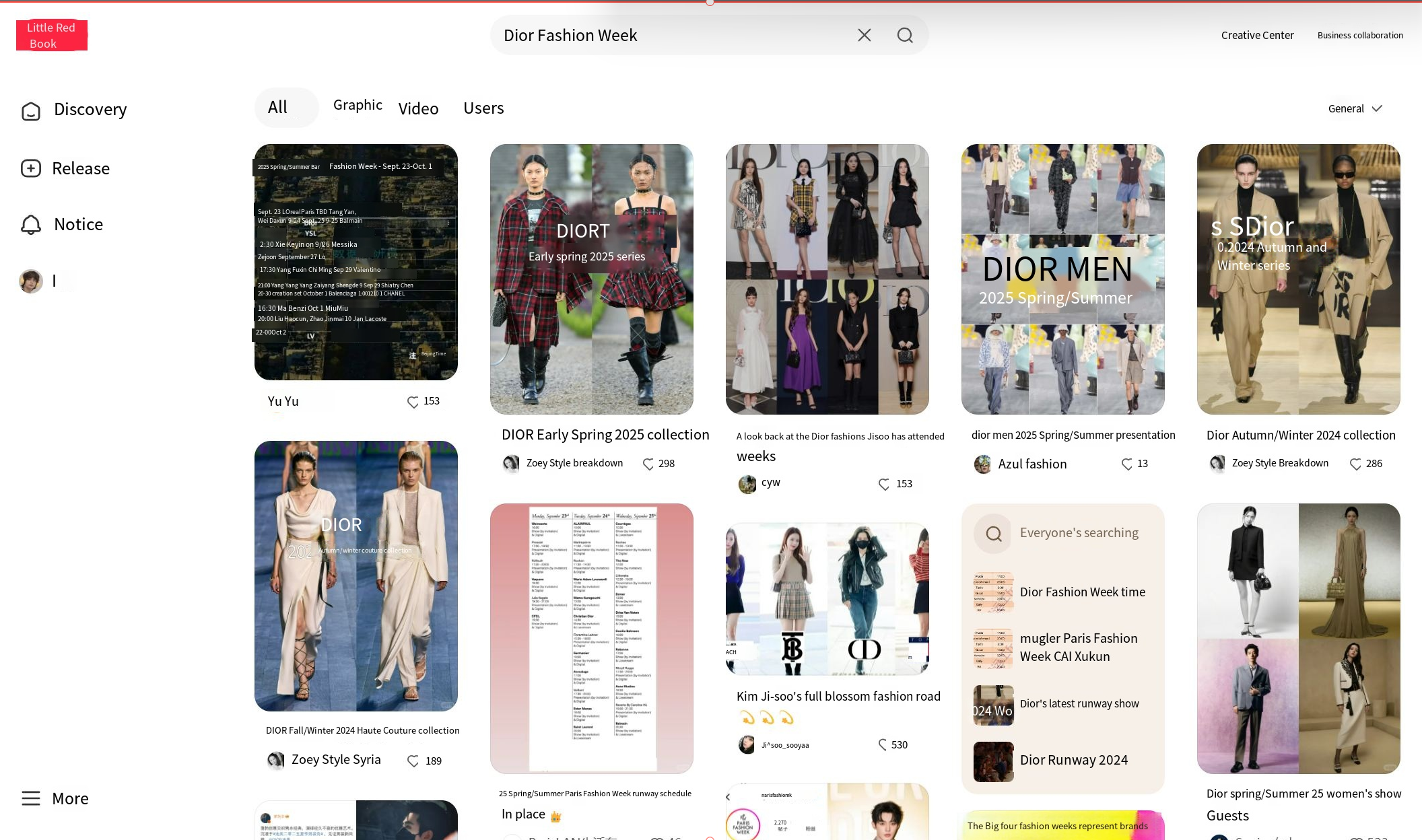
Figure 1: Content about Dior Fashion Week posted by influencers on Red
source: www.xiaohongshu.com
While social media advertising offers significant opportunities, it also carries potential threats that brands like Christian Dior must carefully navigate to preserve their brand image and integrity.
3.3. The power of consumers on social media: a case study of Balenciaga’s crisis communication
On November 16th 2022, Balenciaga released its holiday gifting campaign featuring children surrounded by sadomasochism-inspired teddy bears/handbags(see Figure 2). The backlash from the public was immediate. They accused the brand of sexualizing children and promoting pedophilia. Their actions were posted on social media platforms such as TikTok with the hashtags #burnbalenciaga and #cancelbalenciaga. The video has currently received 300 million views.
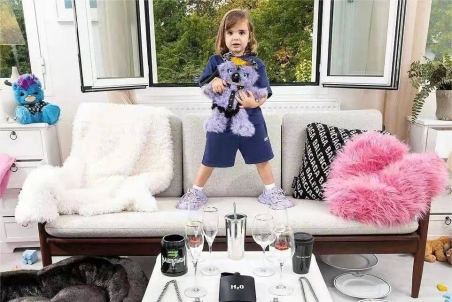
Figure 2: Poster of Balenciaga 2022
The power of WOM on social media is undeniable. As Paula Gárgoles stated in his case study, the rise of new digital technologies has brought a shift in the dynamics and interactions between brands, consumers and online communities, leading to the empowerment of the digital consumer. Word of mouth spreads extremely fast on social media. Riots can be started and organized online, and this puts Balenciaga into a tight spot. The backlash also reached the streets with the vandalization of two flagship stores in Los Angeles and London. The controversy led Balenciaga to an important communication crisis that profoundly damaged the brand’s reputation: social media users, media outlets, celebrities and even a lawsuit were involved [21]. The officials of Balenciaga must organize their words and give a proper explanation that would quell the public's anger.
In fashion industries, the reputation related crisis is most common. However, since the rise of digital technologies and social media, their pace, scope and impact have multiplied, which means that they can quickly go viral. (Gárgoles et al)It is also easier for competitors to intervene when a crisis has appeared for the brand online. For example, when Balenciaga faces a crisis online, Prada or other competitors can stand out and criticize it for its actions; these brands have huge influence online as well as offline.
In the end, Balenciaga deleted all their related posts online and published an apology(see Figure 3). But there is no withdrawing the damage done to the brand's reputation.

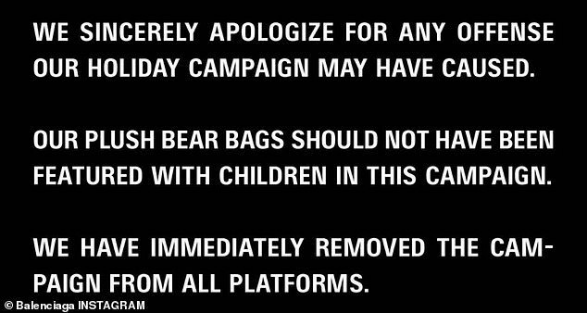
Figure 3: Balenciaga's apology on social media
The photographer in charge of the ad claimed to have nothing to do with the design of the scene, and various models are considering ending a partnership with Balenciaga for its actions. The damage brought to the brand is disastrous. Social media WOM is a powerful tool; brands that decide to enter the online market must consider their posts carefully so that millions of users may supervise them.
4. Findings
The research examines the correlation between luxury brands and younger demographics in social media strategies. Through a systematic case study approach, this research focuses on the consumption habits of young consumers and the social media strategies employed by luxury brands. Consequently, it aims to uncover insights that can contribute to enhancing brand equity, improving business performance, and influencing sales volume shifts.
4.1. Brand-customer relevancy
4.1.1. Cognitive stage
We observe that luxury brands have seamlessly merged physical channels with electronic ones, resulting in short channels where manufacturers can communicate directly with their target audience. By leveraging a significant pool of youthful users and influential software platforms, including Weibo, Xiaohongshu (Red), Instagram, and TikTok, brands showcase their products on the homepage or prime locations within these platforms, leaving a lasting impression on users. Especially in the realm of luxury brands, advertising often aims to evoke fantasies, particularly those linked to attaining a higher social status [22]. As users type in the brand name into the search bar, the exposure to tweets about the brand and its products intensifies, enabling them to become acquainted with the brand, understand its ethos, and eventually fostering a deep-seated connection.
4.1.2. Establishment and consolidation stage
Brands introduce stories and images on social media to communicate the core values of the brand to consumers. And to provide consumers with quality product and service experience consistent with the brand positioning to meet consumers' needs and expectations. Establish a positive relationship with consumers, and communicate and interact effectively with consumers through consumer participation and social media interaction. Such as helping consumers achieve the actual self-congruency. Actual self-congruency is the “congruity between the actual self-image and product image” [23]. According to Onkvisit and Shaw [24], consumers select products and stores that correspond to their self-concept. Our analysis reveals that customers engage with luxury brands on social media because the personality of the luxury brand fits their self- perceptions
4.1.3. Tools
Consumers exhibit a keen interest in brands and are inclined to purchase their products. To cater to this consumer behavior, brands often employ various marketing strategies to entice them to make a purchase. Simultaneously, consumers often rely on the feedback from prior buyers to evaluate the products they are considering, which subsequently informs their decision to buy or not.
4.1.3.1. WOM
In social media, WOM is the most persuasive information source on the Web [25] that have led to significant changes in consumer behaviours [26]. Product reviews and suggestions by users on social media have been shown to be a key factor in determining consumer purchase decisions [27], as they influence the decisions of friends and acquaintances in young consumers’ social communities and other potential consumers who see shared posts.
4.1.3.2. Marketing strategy
Stimulating consumer purchases and cultivating enduring brand loyalty have consistently been at the forefront of luxury brands' marketing objectives. Unlike the traditional offline poster campaigns of the past, today's approaches are more aligned with the evolving demands of the new era. For example, the online launch of new quarterly products (clothing in the form of a show) or high-order products, and some technological means, such as the mini program of brands on WeChat or the online flagship store of Taobao, provide 3D fitting. However, in terms of pricing, luxury brands still adhere to traditional pricing methods to drive consumer purchases, such as premium pricing. The ability of a brand to command a premium price is crucial in enhancing corporate profitability, mitigating business risks, exerting leverage in negotiations and price hikes, and sustaining long-term growth.
4.2. Perceived content
4.2.1. Content marketing
As mentioned in the case study, luxury brands are increasingly leveraging content marketing strategies to forge deeper connections with their customers, particularly among the younger demographic that favors novel forms of online social engagement. This approach not only engages consumers but also enables brands to interact with them in ways that were not possible before the advent of the internet. Consumers can now simply peruse pictures and text, eliminating the need to physically visit a store to discover desired or intriguing products. Social media has significantly enriched the consumer experience for luxury brands. All that the brand needs to do is create engaging content that resonates with its target audience.
4.2.2. Celebrity endorsement
The current study reveals that the utilization of actresses, sporting icons, fashion models, and music superstars is highly prevalent in modern marketing and advertising campaigns [28]. Celebrities typically possess high visibility and a vast fan base, which allows them to swiftly capture consumers' attention. Their influence often transcends geographical and demographic boundaries, thereby enhancing the products' exposure and publicity effects. When celebrities endorse or collaborate with brands, they often wear the brand's products and share pictures on social media platforms, as seen in Figure 4. The image and persona of these celebrities can lend a specific aura and quality to a brand, assisting in the cultivation of a distinct brand identity and value proposition. Consumers tend to transfer their fondness and trust for celebrities to the brands or products they endorse, thereby enhancing their trust in those brands and stimulating purchase intentions.
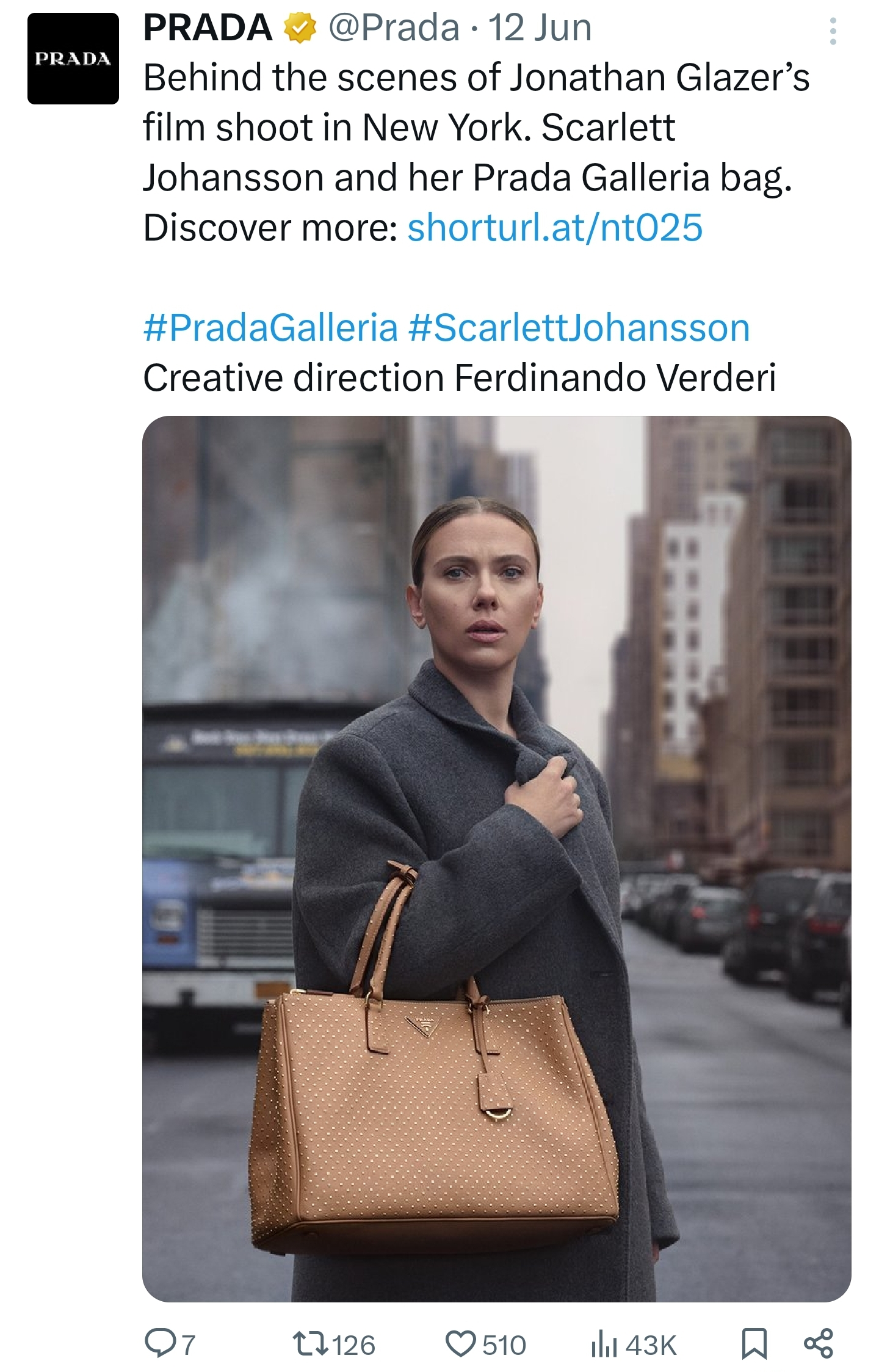
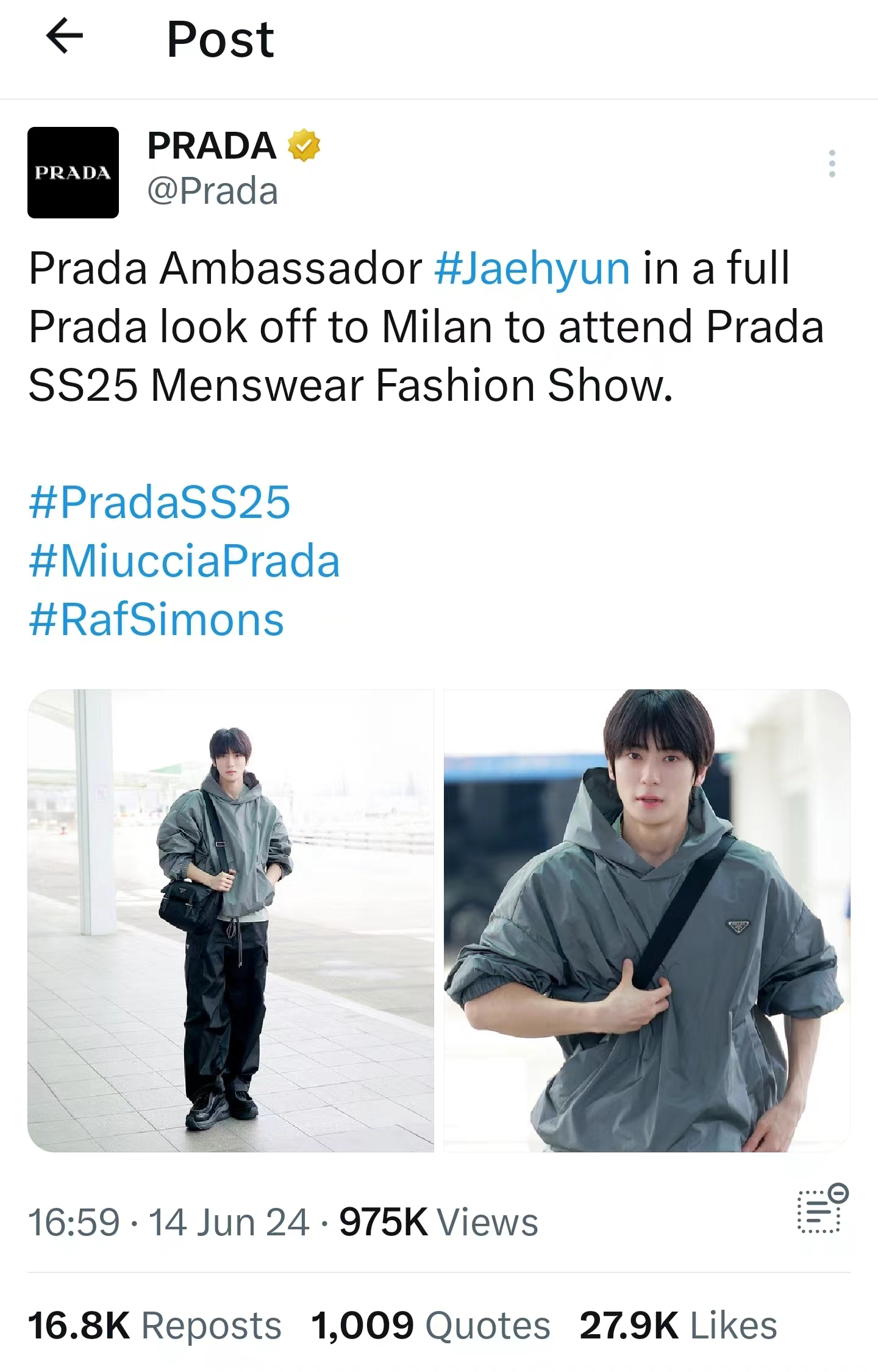
Figure 4: Prada's X campaign photos of celebrities
Source: https://x.com/Prada
5. Limitation and future research
Regarding the investigation into young people's fascination with luxury goods through social media, our Research endeavor offers pertinent findings and perspectives, aiming to address the existing knowledge gap in this domain. While our study has successfully achieved its research aims, it is crucial to acknowledge certain limitations. Specifically, our case study did not involve a holistic societal survey based on the selected sample size, nor did it account for the influence of temporal factors. Consequently, we lack a statistical framework to demonstrate the impact of social media on young people's perception of luxury goods.
Furthermore, our study has a general and macro-level scope. Future research endeavors could capitalize on the datasets to quantitatively delve into distinct subgroups of individuals, taking into account varying educational levels or cultural backgrounds. Additionally, a deeper examination of social media strategies would offer further insights into this complex phenomenon.
6. Conclusion
The study establishes a need to incorporate social media when targeting young consumers, particularly Millennial and Gen Z markets because they are less sensitive to print media, celebrity endorsement, and fashion shows. Instead, they seek authenticity, immediacy, and, most importantly, visual content, which, in turn, social media applications such as Facebook, Instagram, and TikTok provide. Through these channels, Brands can communicate the concepts of exclusivity, high quality, and novelty. Therefore, luxury brands need proper strategies for social media marketing, which are different from traditional brands.
Building an impactful social media presence entails developing a content creation process that focuses on the post’s young consumers and targets them through visuals and real-life engagements. The brands should strive to create some form of an emotional bond that is established by posting images and messages that their audience would be interested in, such as pictures and or messages that relate to the behind-the-scenes company history, company history, and how products are manufactured, among others. This, in turn, not only increases brand recognition but also builds brand loyalty and gets the consumers involved. With more than 600 million daily active users, TikTok China is a vast traffic pool for any brand. According to TikTok China Luxury Gravitation Center, the online content platform TikTok represents has become the first channel for Chinese consumers to learn more about brands. They consider TikTok China's luxury demographic to have active users of over 40 million people, potential users of about 70 million, and interest users of more than 150 million.
Social Media marketing is, however, faced with the following limitations. The dynamic and frequent change in patterns within social media platforms requires constant updates and brand innovation. Failing to do so can mean losing customers’ attention and, thus, reduced brand exposure. Similarly, while social media gives brands access to a large coverage area, it also makes brands vulnerable to certain risk factors, like negative publicity that could go viral, thus negatively affecting the brand. Another issue is maintaining consistency in the branding effort, as different platforms may call for dissimilar content and communication tones.
The existing literature on social media marketing for luxury brands faces several limitations. Much of the research focuses on Western markets, often neglecting insights from emerging markets like China and India, where social media usage patterns and consumer behaviours differ significantly. Also, most of the literature reviewed in this study needs to satisfactorily explore how multiple social media platforms can be integrated into the context of a consistent brand message. While many of the studies focus on individual platforms, more research needs to be done on the combined strategic value of the media.
This paper is essential to academia in several ways because it fills the following gaps within the literature. It explains how luxury brands could use social media to interact with Millennial and Gen-Z consumers, especially in non-western countries. This research also seeks to analyse the relations between various social media platforms and explain how consistency in using the platforms will increase the visibility of brands and consumers.
Apart from theoretical contributions, the present study provides essential recommendations for luxury brands interested in a stronger market position. These insights reveal how fine-tuning marketing approaches to correspond with Millennial and Gen Z consumers will yield higher engagement rates overall. Featuring real-life interactions and more ‘backstage’ aspects can demystify brands and make them more credible to an audience. All these strategies assist in enhancing the visibility of the brand and its identification in the market, thus strengthening market loyalty and enhancing the extent to which the buyer gets involved in the brand, contributing positively to the sales and market share of the product.
More targeted studies within different consumer subgroups are needed to improve marketing communications strategies. For instance, comparing and contrasting young consumers in urban and rural areas will likely establish essential differences concerning crop usage of social media and brand relations. Research may also focus on cultural distinctiveness and its influence on consumer behaviour across different international markets, enabling brands to tailor their approach better. Lastly, exhaustive research to know the shifts in consumer preferences over time could provide brands with the much-needed edge in anticipating the probable changes that might affect consumer buying behaviour.
Acknowledgement
Qiupeng Chen, Zeju Li, Lei Zhao, Ziqing An and Xinyue Qiu contributed equally to this work and should be considered co-first authors.
References
[1]. Dobre, C., Milovan, A., Duțu, C., Preda, G., & Agapie, A. (2021). The common values of social media marketing and luxury brands. The millennials and Generation Z perspective. Journal of Theoretical and Applied Electronic Commerce Research, 16(7), 2532-2553. https://doi.org/10.3390/jtaer16070139
[2]. Godey, B., Manthiou, A., Pederzoli, D., Rokka, J., Aiello, G., Donvito, R., & Singh, R. (2016). Social media marketing efforts of luxury brands: Influence on brand equity and consumer behavior. Journal of Business Research, 69(12), 5833-5841. https://doi.org/10.1016/j.jbusres.2016.04.181
[3]. Miller, K.D., Fabian, F. and Lin, S.J. (2009) 'Strategies for online communities', Strategic Management Journal, 30(3), pp. 305–322
[4]. Sijabat, L., Rantung, D. I., & Mandangi, D. W. (2022). The Role of Social Media Influencers in Shaping Customer Brand Engagement and Brand Perception.
[5]. Deloitte. (2019) Global powers of luxury goods (2019): Bridging the gap between the old and the new. Touche Tohmatsu Limited. Available at: https://www2.deloitte.com/global/en/pages/consumer-business/articles/gx-cb-global-powers-of-luxury-goods.html.
[6]. van Reijmersdal, E. A., Rozendaal, E., Hudders, L., Vanwesenbeeck, I., Cauberghe, V., & van Berlo, Z. M. (2020). Effects of disclosing influencer marketing in videos: An eye tracking study among children in early adolescence. Journal of Interactive Marketing, 49, 94–106.https://doi.org/10.1016/j.intmar.2019.09.001
[7]. Statista. (2019). Impact of influencers on global consumer purchasing in 2018, by influencer tier. Available at: https://www.statista.com/statistics/956197/influencer-impact-on-purchasing-decisions/#statisticContainer
[8]. Blumler, J. G., & Katz, E. (1974). The uses of mass communications: Current perspectives on gratifications research, (Vol. 1974). Sage Publications Inc.
[9]. Katz, E. (1959). Mass Communications Research and the Study of Popular Culture: An Editorial Note on a Possible Future for This Journal. Studies in Public Communication, 2 1-6. Retrieved from http://repository.upenn.edu/asc_papers/165
[10]. Krause, A. E., North, A. C., & Heritage, B. (2014). The uses and gratifications of using Facebook music listening applications. Computers in Human Behavior, 39, 71–77. https://doi.org/10.1016/j.chb.2014.07.001
[11]. J.Phua,S.V.Jin,J.J.Kim(2017)GratificationsofusingFacebook,Twitter,Instagram,orSnapchattofollowbrands: The moderating effect of social comparison, trust, tie strength, and network homophily on brand identification, brand engagement, brand commitment, and membership intention ,34 , pp. 412-424, 10.1016/j.tele.2016.06.004
[12]. Park, J., Hyun, H., & Thavisay, T. (2020). A study of antecedents and outcomes of social media WOM towards luxury brand purchase intention. Journal of Retailing and Consumer Services, 58, 102272. https://doi.org/10.1016/j.jretconser.2020.102272
[13]. Dwivedi, A., Nayeem, T., & Murshed, F. (2018). Brand experience and consumers’ willingness-to-pay (WTP) a price premium: Mediating role of brand credibility and perceived uniqueness. Journal of Retailing and Consumer Services, 44, 100–107. https://doi.org/10.1016/j.jretconser.2018.06.009
[14]. Mavruk, C.K., & Weller, J. (2017). Paradoxical Consumption Practices and Creative Identity Work in Consumption Styles – The Concept of Reflexive Bricolage.
[15]. Augusto, L. F., Santos, S., & Manuel, P. (2020). Willingness to Pay a Premium Price for Streaming Services: The Role of Trust in Services. ResearchGate. Available at: https://www.researchgate.net/publication/337633728_Willingness_to_Pay_a_Premium_Price_for_Streaming_Services_The_Role_of_Trust_in_Services
[16]. Lim, W. M., & Rasul, T. (2022). Customer engagement and social media: Revisiting the past to inform the future. Journal of Business Research, 148, 325–342. https://doi.org/10.1016/j.jbusres.2022.04.068
[17]. International Journal of Current Science Research and Review. (2020). Single view - International Journal of Current Science Research and Review. Available at: https://ijcsrr.org/single-view/?id=12584&pid=12525
[18]. da Cunha Brandão, A.M.P. and Barbedo, H.E.M. (2022). Going (in)conspicuous: antecedents and moderators of luxury consumption. Journal of Marketing Analytics, [online] 11(2), pp.202–218. doi:https://doi.org/10.1057/s41270-022-00157-8.
[19]. Goor, D., Ordabayeva, N., Keinan, A. and Crener, S. (n.d.). The Impostor Syndrome from Luxury Consumption. Available at: https://www-2.rotman.utoronto.ca/userfiles/seminars/marketing/files/JMP%20Goor%20-%20The%20Impostor%20Syndrome%20from%20Luxury%20Consumption.pdf.
[20]. Aragoncillo, L., & Orus, C. (2018). Impulse buying behaviour: an online-offline comparative and the impact of social media. Spanish Journal of Marketing - ESIC, 22(1), 42–62. https://doi.org/10.1108/sjme-03-2018-007
[21]. Gárgoles, P., Ambás, G. (2023). The Power of Consumers on Social Media: A Case Study of Balenciaga’s Crisis Communication. In: Sabatini, N., Sádaba, T., Tosi, A., Neri, V., Cantoni, L. (eds) Fashion Communication in the Digital Age. FACTUM 2023. Springer Proceedings in Business and Economics. Springer, Cham. https://doi.org/10.1007/978-3-031-38541-4_1
[22]. Kapferer, J., -N, & Bastien, V. (2009). The specificity of luxury management: Turning marketing upside down. Journal of Brand Management, 16(5), 311-322.
[23]. Sirgy, M. J. (1985). Using self-congruity and ideal congruity to predict purchase motivation. Journal of Business Research, 13(3), 195–206.
[24]. Onkvisit, S., & Shaw, J. (1987). Self-concept and image congruence: Some research and managerial implications. Journal of Consumer Marketing, 4(1), 13–23.
[25]. Abubakar, A.M., Ilkan, M., (2016). Impact of online WOM on destination trust and intention to travel: a medical tourism perspective. JDMM 5, 192–201. https://doi.org/10.1016/j.jdmm.2015.12.005.
[26]. G´ omez-Su´arez, M., Martínez-Ruiz, M.P., Martínez-Caraballo, N., (2017). Consumer-brand relationships under the marketing 3.0 paradigm: a literature review. Front. Psychol. 8, 8–11.
[27]. Farzin, M., Fattahi, M., (2018). eWOM through social networking sites and impact on purchase intention and brand image in Iran. JAMR 15 (2), 161–183.
[28]. Choi, S. M., Lee, W.-N., & Kim, H.-J. (2005). Lessons from the rich and famous: A CrossCultural Comparison of Celebrity Endorsement in Advertising. Journal of Advertising
Cite this article
Chen,Q.;Li,Z.;Zhao,L.;An,Z.;Qiu,X. (2025). Effective Social Media Strategies for Engaging Younger Audiences: Best Practices for Luxury Brands Targeting Millennials and Gen Z. Communications in Humanities Research,70,57-68.
Data availability
The datasets used and/or analyzed during the current study will be available from the authors upon reasonable request.
Disclaimer/Publisher's Note
The statements, opinions and data contained in all publications are solely those of the individual author(s) and contributor(s) and not of EWA Publishing and/or the editor(s). EWA Publishing and/or the editor(s) disclaim responsibility for any injury to people or property resulting from any ideas, methods, instructions or products referred to in the content.
About volume
Volume title: Proceedings of the 3rd International Conference on Interdisciplinary Humanities and Communication Studies
© 2024 by the author(s). Licensee EWA Publishing, Oxford, UK. This article is an open access article distributed under the terms and
conditions of the Creative Commons Attribution (CC BY) license. Authors who
publish this series agree to the following terms:
1. Authors retain copyright and grant the series right of first publication with the work simultaneously licensed under a Creative Commons
Attribution License that allows others to share the work with an acknowledgment of the work's authorship and initial publication in this
series.
2. Authors are able to enter into separate, additional contractual arrangements for the non-exclusive distribution of the series's published
version of the work (e.g., post it to an institutional repository or publish it in a book), with an acknowledgment of its initial
publication in this series.
3. Authors are permitted and encouraged to post their work online (e.g., in institutional repositories or on their website) prior to and
during the submission process, as it can lead to productive exchanges, as well as earlier and greater citation of published work (See
Open access policy for details).
References
[1]. Dobre, C., Milovan, A., Duțu, C., Preda, G., & Agapie, A. (2021). The common values of social media marketing and luxury brands. The millennials and Generation Z perspective. Journal of Theoretical and Applied Electronic Commerce Research, 16(7), 2532-2553. https://doi.org/10.3390/jtaer16070139
[2]. Godey, B., Manthiou, A., Pederzoli, D., Rokka, J., Aiello, G., Donvito, R., & Singh, R. (2016). Social media marketing efforts of luxury brands: Influence on brand equity and consumer behavior. Journal of Business Research, 69(12), 5833-5841. https://doi.org/10.1016/j.jbusres.2016.04.181
[3]. Miller, K.D., Fabian, F. and Lin, S.J. (2009) 'Strategies for online communities', Strategic Management Journal, 30(3), pp. 305–322
[4]. Sijabat, L., Rantung, D. I., & Mandangi, D. W. (2022). The Role of Social Media Influencers in Shaping Customer Brand Engagement and Brand Perception.
[5]. Deloitte. (2019) Global powers of luxury goods (2019): Bridging the gap between the old and the new. Touche Tohmatsu Limited. Available at: https://www2.deloitte.com/global/en/pages/consumer-business/articles/gx-cb-global-powers-of-luxury-goods.html.
[6]. van Reijmersdal, E. A., Rozendaal, E., Hudders, L., Vanwesenbeeck, I., Cauberghe, V., & van Berlo, Z. M. (2020). Effects of disclosing influencer marketing in videos: An eye tracking study among children in early adolescence. Journal of Interactive Marketing, 49, 94–106.https://doi.org/10.1016/j.intmar.2019.09.001
[7]. Statista. (2019). Impact of influencers on global consumer purchasing in 2018, by influencer tier. Available at: https://www.statista.com/statistics/956197/influencer-impact-on-purchasing-decisions/#statisticContainer
[8]. Blumler, J. G., & Katz, E. (1974). The uses of mass communications: Current perspectives on gratifications research, (Vol. 1974). Sage Publications Inc.
[9]. Katz, E. (1959). Mass Communications Research and the Study of Popular Culture: An Editorial Note on a Possible Future for This Journal. Studies in Public Communication, 2 1-6. Retrieved from http://repository.upenn.edu/asc_papers/165
[10]. Krause, A. E., North, A. C., & Heritage, B. (2014). The uses and gratifications of using Facebook music listening applications. Computers in Human Behavior, 39, 71–77. https://doi.org/10.1016/j.chb.2014.07.001
[11]. J.Phua,S.V.Jin,J.J.Kim(2017)GratificationsofusingFacebook,Twitter,Instagram,orSnapchattofollowbrands: The moderating effect of social comparison, trust, tie strength, and network homophily on brand identification, brand engagement, brand commitment, and membership intention ,34 , pp. 412-424, 10.1016/j.tele.2016.06.004
[12]. Park, J., Hyun, H., & Thavisay, T. (2020). A study of antecedents and outcomes of social media WOM towards luxury brand purchase intention. Journal of Retailing and Consumer Services, 58, 102272. https://doi.org/10.1016/j.jretconser.2020.102272
[13]. Dwivedi, A., Nayeem, T., & Murshed, F. (2018). Brand experience and consumers’ willingness-to-pay (WTP) a price premium: Mediating role of brand credibility and perceived uniqueness. Journal of Retailing and Consumer Services, 44, 100–107. https://doi.org/10.1016/j.jretconser.2018.06.009
[14]. Mavruk, C.K., & Weller, J. (2017). Paradoxical Consumption Practices and Creative Identity Work in Consumption Styles – The Concept of Reflexive Bricolage.
[15]. Augusto, L. F., Santos, S., & Manuel, P. (2020). Willingness to Pay a Premium Price for Streaming Services: The Role of Trust in Services. ResearchGate. Available at: https://www.researchgate.net/publication/337633728_Willingness_to_Pay_a_Premium_Price_for_Streaming_Services_The_Role_of_Trust_in_Services
[16]. Lim, W. M., & Rasul, T. (2022). Customer engagement and social media: Revisiting the past to inform the future. Journal of Business Research, 148, 325–342. https://doi.org/10.1016/j.jbusres.2022.04.068
[17]. International Journal of Current Science Research and Review. (2020). Single view - International Journal of Current Science Research and Review. Available at: https://ijcsrr.org/single-view/?id=12584&pid=12525
[18]. da Cunha Brandão, A.M.P. and Barbedo, H.E.M. (2022). Going (in)conspicuous: antecedents and moderators of luxury consumption. Journal of Marketing Analytics, [online] 11(2), pp.202–218. doi:https://doi.org/10.1057/s41270-022-00157-8.
[19]. Goor, D., Ordabayeva, N., Keinan, A. and Crener, S. (n.d.). The Impostor Syndrome from Luxury Consumption. Available at: https://www-2.rotman.utoronto.ca/userfiles/seminars/marketing/files/JMP%20Goor%20-%20The%20Impostor%20Syndrome%20from%20Luxury%20Consumption.pdf.
[20]. Aragoncillo, L., & Orus, C. (2018). Impulse buying behaviour: an online-offline comparative and the impact of social media. Spanish Journal of Marketing - ESIC, 22(1), 42–62. https://doi.org/10.1108/sjme-03-2018-007
[21]. Gárgoles, P., Ambás, G. (2023). The Power of Consumers on Social Media: A Case Study of Balenciaga’s Crisis Communication. In: Sabatini, N., Sádaba, T., Tosi, A., Neri, V., Cantoni, L. (eds) Fashion Communication in the Digital Age. FACTUM 2023. Springer Proceedings in Business and Economics. Springer, Cham. https://doi.org/10.1007/978-3-031-38541-4_1
[22]. Kapferer, J., -N, & Bastien, V. (2009). The specificity of luxury management: Turning marketing upside down. Journal of Brand Management, 16(5), 311-322.
[23]. Sirgy, M. J. (1985). Using self-congruity and ideal congruity to predict purchase motivation. Journal of Business Research, 13(3), 195–206.
[24]. Onkvisit, S., & Shaw, J. (1987). Self-concept and image congruence: Some research and managerial implications. Journal of Consumer Marketing, 4(1), 13–23.
[25]. Abubakar, A.M., Ilkan, M., (2016). Impact of online WOM on destination trust and intention to travel: a medical tourism perspective. JDMM 5, 192–201. https://doi.org/10.1016/j.jdmm.2015.12.005.
[26]. G´ omez-Su´arez, M., Martínez-Ruiz, M.P., Martínez-Caraballo, N., (2017). Consumer-brand relationships under the marketing 3.0 paradigm: a literature review. Front. Psychol. 8, 8–11.
[27]. Farzin, M., Fattahi, M., (2018). eWOM through social networking sites and impact on purchase intention and brand image in Iran. JAMR 15 (2), 161–183.
[28]. Choi, S. M., Lee, W.-N., & Kim, H.-J. (2005). Lessons from the rich and famous: A CrossCultural Comparison of Celebrity Endorsement in Advertising. Journal of Advertising





